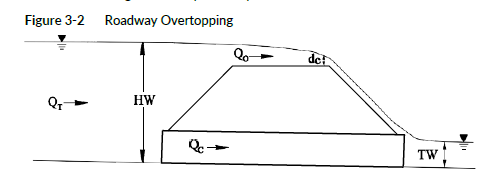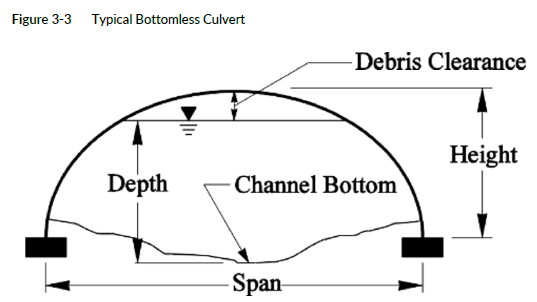This section presents hydraulic design criteria for allowable headwater for circular and box culverts and pipe arches and for bottomless culverts.
3-3.2.1 General
The depth of water that exists at the culvert entrance at a given design flow is referred to as the headwater. Headwater depth is measured from the invert of the culvert to the water surface, as shown in Figure 3-1. See the glossary for definitions.

Limiting the amount of headwater during a design flow can be beneficial for several reasons. The potential for debris clogging reduces as the culvert size is increased. Maintenance is virtually impossible to perform on a culvert during a flood event if the inlet is submerged more than a few feet. Also, increasing the allowable headwater can adversely impact upstream property owners by increasing flood elevations. These factors must be taken into consideration and balanced with the cost-effectiveness of providing larger or smaller culvert openings.
If a culvert is to be placed in a stream that has been identified in a FEMA flood insurance study, the floodway and floodplain requirements for that municipality may govern the allowable amount of headwater. In this situation, the PEO shall contact the State Hydraulics Office for additional guidance.
3-3.2.2 Allowable Headwater for Circular and Box Culverts and Pipe Arches
Circular culverts, box culverts, and pipe arches shall be designed such that the ratio of the headwater (HW) to diameter (D) during the 25-year flow event is less than or equal to 1.25 (HW/D <1.25). HW/D ratios larger than 1.25 are permitted, provided that existing site conditions dictate or warrant a larger ratio. An example of this might be an area with high roadway fills, little stream debris, and no impacted upstream property owners. The justification for exceeding the HW/D ratio of 1.25 must be discussed with the State Hydraulics Office and, if approved by the RHE, included as a narrative in the hydraulic report.
The headwater that occurs during the 100-year flow event must also be investigated. Two sets of criteria exist for the allowable headwater during the 100-year flow event, depending on the type of roadway over the culvert:
1. If the culvert is under an interstate or major state route that must be kept open during major flood events, the culvert must be designed such that the 100-year flow event can be passed without overtopping the roadway.
2. If the culvert is under a minor state route or other roadway, the culvert shall be designed such that there is no roadway overtopping during the 100-year flow event. However, there may be situations where it is more cost-effective to design the roadway embankment to withstand overtopping rather than provide a structure or group of structures capable of passing the design flow. An example of this might be a low average daily traffic roadway with minimal vertical clearance that, if closed because of overtopping, would not significantly inconvenience the primary users.
Overtopping of the road will begin to occur when the headwater rises to the elevation of the road. The flow over the roadway will be similar to flow over a broad-crested weir, as shown in Figure 3-2. A methodology is available in HDS-5 to calculate the simultaneous flows through the culvert and over the roadway. The PEO must be mindful that the downstream embankment slope must be protected from the erosive forces that will occur. This can generally be accomplished with riprap reinforcement, but the State Hydraulics Office should be contacted for further design guidance. Additionally, the PEO should verify that the adjacent ditch does not overtop and transport runoff, causing damage to either public or private infrastructure.

3-3.2.3 Allowable Headwater for Bottomless Culverts
Bottomless culverts with footings shall be designed such that 1 foot of debris clearance from the water surface to the culvert crown is provided during the 25-year flow event (see Figure 3-3). In many instances, bottomless culverts function similarly to bridges. They usually span the main channel and are designed to pass relatively large flows. If a large arch becomes plugged with debris, the potential for significant damage occurring to either the roadway embankment or the culvert increases.
Excessive headwater at the inlet can also increase velocities through the culvert and correspondingly increase the scour potential at the footings. Sizing a bottomless culvert to meet the 1-foot criterion will alleviate many of these potential problems. Bottomless culverts shall also be designed such that the 100-year flow event can be passed without the headwater depth exceeding the height of the culvert. Flow depths greater than the height can cause potential scour problems near the footings. A scour analysis shall be conducted for the footing.

